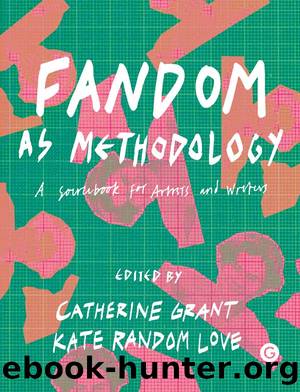Fandom as Methodology by Catherine Grant

Author:Catherine Grant
Language: eng
Format: epub
Publisher: MIT Press
6
âShippingâ (as) Fandom and Art Practice
Owen G. Parry (owko69)
This chapter draws a relationship between fandom and contemporary art by turning to fandom as a site of inspiration and motivation in my own art practice. In 2015 I initiated the Fan Riot project, an expansive art project exploring an increased resonance between art and fandom since the Internet.1 Re-imagining the canonical tropes of relational aesthetics and the archival turn in contemporary art, Fan Riot explores the figure of the adoring fan as an unassuming model for collectivity, mobilisation and revolt. Fan Riot includes a fan club series with contributing fans and artists working with fan-like tendencies; publications exploring the relationship between critical art writing and fanfiction; and a series of artworks and performances, including two works commissioned by Jerwood Visual Arts, London in 2016 that I will discuss here: Larry!Monument a multimedia installation and fictional monument to the Larry Stylinson fandom, focused on the romantic relationship between One Direction boy band members Louis Tomlinson and Harry Styles as imagined-into-being by their adoring fans; and Larry Stylinson Performance AU, a role-play performance staged at the monument and performed by two Larry lookalikes.
More specifically this chapter turns to âshippingâ: a speculative method in fanfiction of creating new erotic relationships between characters or celebrities un-substantiated in the official narratives or source texts, and characterised through fan-authored processes of imagining, re-writing and âfictioning.â2 Shipping, initially derived from the word ârelationship,â âis the desire by fans for two or more people, either real-life-people or fictional characters (in film, literature, television, etc.) to be in a relationship, romantic or otherwise.â3 Shipping manifests through practice in the formation of transformative works including fanfictions, vids, illustrations and memes self-published on Internet platforms like tumblr, YouTube, fanfiction.net and archive of our own and includes an infinity of possible narratives: fans of, for example, Harry Potter or boy band One Direction create transformative works by using those official, usually commercially driven texts and narratives to create their very own versions, whether that be a âcurtain ficâ (or domestic fic) in which an enamoured Snape and Harry go shopping for curtains; a hurt/comfort fic (or death fic) where one band member, Louis, cares for the other band member, Harry, who has a terminal illness; or a One Direction/Harry Potter crossover in which Harry Potter is a performance artist and Harry Styles an art critic who âbodyswapâ to help each other out of âstickyâ situations.
An exclamation mark (sometimes called a âbangâ) between two words in fandom, for instance âMarried!Larry,â denotes a trait!character relationship between a character and a trait of that character. There are infinite possibilities for re-working popular texts, but fanfiction mostly focuses on relationships between characters, or celebrities in real-person fiction (RPF). The romance genre is thus the most popular, and includes specialist tropes like shipping; âone true pairingâ (OTP â a fanâs favourite romantic pairing or âshipâ); and slash or femme slash, focused on a same-sex relationship or narrative, âusually one imposed by the author and based on perceived homoerotic subtext.
Download
This site does not store any files on its server. We only index and link to content provided by other sites. Please contact the content providers to delete copyright contents if any and email us, we'll remove relevant links or contents immediately.
| Authorship | Bibliographies & Indexes |
| Book Industry |
Asking the Right Questions: A Guide to Critical Thinking by M. Neil Browne & Stuart M. Keeley(5705)
Autoboyography by Christina Lauren(5202)
Eat That Frog! by Brian Tracy(4479)
Dialogue by Robert McKee(4352)
Sticky Fingers by Joe Hagan(4142)
Journeys Out of the Body by Robert Monroe(3588)
Annapurna by Maurice Herzog(3445)
Full Circle by Michael Palin(3413)
Schaum's Quick Guide to Writing Great Short Stories by Margaret Lucke(3342)
Elements of Style 2017 by Richard De A'Morelli(3323)
The Art of Dramatic Writing: Its Basis in the Creative Interpretation of Human Motives by Egri Lajos(3035)
Atlas Obscura by Joshua Foer(2925)
Why I Write by George Orwell(2911)
The Diviners by Libba Bray(2905)
In Patagonia by Bruce Chatwin(2893)
The Fight by Norman Mailer(2884)
The Mental Game of Writing: How to Overcome Obstacles, Stay Creative and Productive, and Free Your Mind for Success by James Scott Bell(2873)
Venice by Jan Morris(2545)
The Elements of Style by William Strunk and E. B. White(2452)
